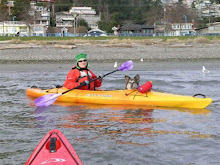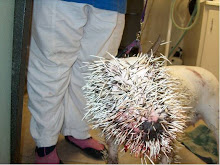Alot of people come into the caboose here at the Kids Market on Granville Island and inquire about the caboose here.
The caboose pictured at right and way below was from what I have been told an old CP railcar that was used right up until Granville Island was set up. It has been a few different things like a daycare, a photo studio but most noteably a Pet Boutique..which is of course us Woofles and Meowz.
We are located right outside of the Kids Market which was a building that originally made paint for the commercial trade. If you go in that building you can still see remnants of the large round room that held the vat. If you look way up you can see the loft where they added the ingredients which is a "way cool" office/storage place.
Below is the history of the island:
The Granville Island Story
Granville Island is a forty-acre man made island created in 1917. For fifty years it housed heavy industry.
During the depression, hundreds of families lived on Granville Island, then known as "Mud Island". The shantytown settlement was called "Bennettville" after the former Prime Minister of Canada, Richard B. Bennett.
Families on the island operated small boats or sold salmon or buckets of smelt door to door to survive. They were basically self-sufficient and were left alone by city officials until 1949 when seven hundred people were given eviction notices. Most families eventually moved off the island by the late 1950's.
The Granville Island Museums run along Broker's Bay, once referred to as "Rat Portage". This was one of two entrances to the island during the 1930's. A second entry was a stairway leading from the old Granville Street Bridge to the shantytown settlement on the island. During World War II the stairway was closed for fear of sabotage.
In the 1970's, the Federal Government developed a plan, creating a partnership between government and private enterprise. The Granville Island Concept -- a recycling of old buildings and an orchestrated mix of tenants was designed to maintain an equally busy evening environment as it was during the day by local residents and tourists alike. Also, development was not to compete with other city zoning. Special features were kept or enhanced such as the metal or stucco siding, heavy timber structures, large doors, and mulit-paned industrial glazed windows and skylights.
The Sidney Roofing & Paper Company building, home of the Granville Island Museums, was built in 1936 by Townley & Matheson Architects, and then renovated in the 1980's - Art Deco.
Today, so commercially popular, some of the original low profit businesses are being squeezed out. There is however still a good representation of live theatre, marine stores, a wonderful public market, an art school and three unique museums that fulfil its original mandate. Since the islands new beginning 21 years ago, it currently sits in the middle of the newly developed False Creek area. This area occupies some 30,00 new residents who routinely shop at Granville Island along with the regional and international visitors, In total, Granville Island now receives over 12 million visitors a year. This number is calculated by the traffic flow from cars and the aqua busses that stop on the island though probably not an exact science.
Granville Island , now well placed, answers the various needs of the whole family. Dad can visit the sport fishing museum, Mom can go the the public market, while Grandma takes the little ones to the Kid's Market, or to the train museum. They can all meet for lunch or dinner at one of the restaurants such as Bridges or the Keg and then they can charter a harbour cruise. The options are numerous.
Behind the Scenes - Granville Island is one of the few, very pleasant destinations that offers more comprehensive activities for families than any other location in the province, and one of the few successful partnership between public and private enterprise.
For an economical investment of $19 million in the late 1970's, the Federal government now reaps over double that a year in taxes.
Wednesday, April 23, 2008
Subscribe to:
Post Comments (Atom)

































No comments:
Post a Comment